Trucking boosts adult returns for most Sacramento Valley rivers
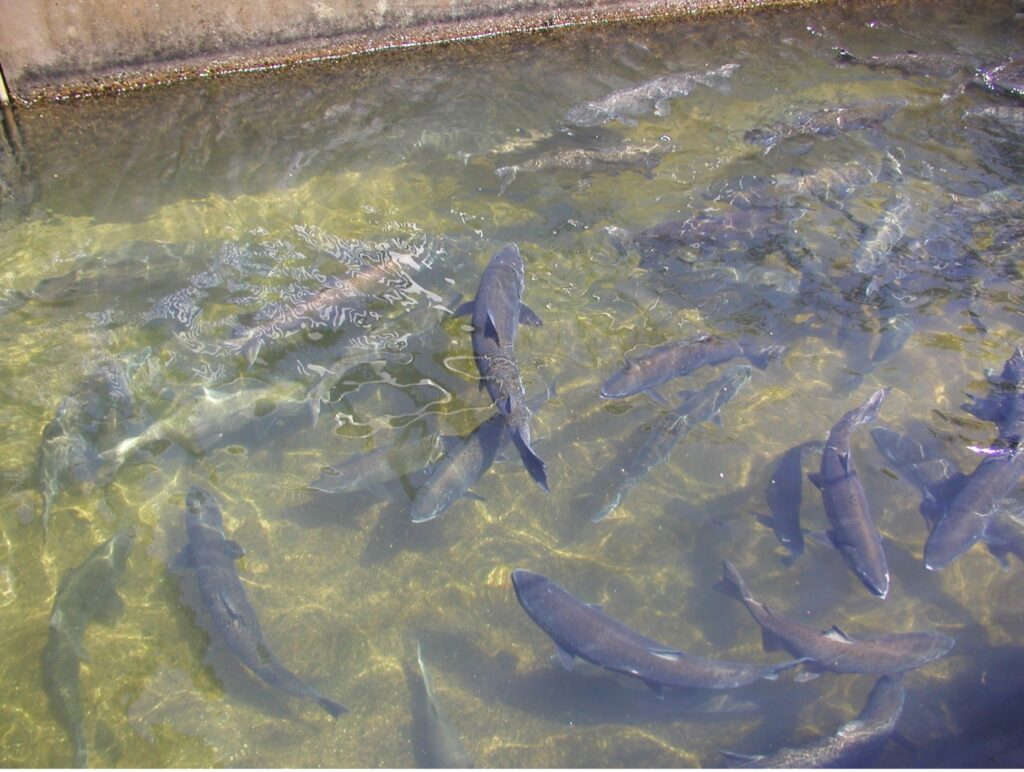
Some have questioned whether or not trucked fish return to their birth stream. In the case of fish from the Coleman Hatchery, located hundreds of miles up the Sacramento River, the answer is that if hatchery fish are trucked to the Delta or Bay, they’ll return to the Central Valley in substantially higher numbers but most will stray and not find their way back to the hatchery. GSSA is working with the USFWS to find out if they can be trucked part way and find their way home.
However, in the case of fish born at the Feather River Hatchery or Nimbus Hatchery on the American River, the answer is that trucking increases returns back home. Commonly, the return of trucked fish to the Feather and American rivers far outnumber fish from the same hatcheries that are released at the hatchery. Sometimes releasing the trucked fish just a little further west, from Vallejo to Sausalito, can almost double their survival with minimal increased straying.
Coded wire tag data from Feather River hatchery fish that returned to the Feather in the fall of 2018 provides a good example of what’s going on. For every 100,000 released into the Feather River at the hatchery, 106 returned to the river as two-year-olds and 21 returned to the river as three-year-olds. So for those year classes, 100,000 fish released in the river resulted in 127 coming back to the same river. By comparison, for every 100,000 fish trucked to San Pablo Bay (released at Mare Island near Vallejo) 141 returned to the Feather River as two-year-olds and 607 returned to the river as three-year-olds for a total of 748. This does not include additional fish that strayed.
Coded wire tag data from releases at the Golden Gate Bridge (Ft. Baker in Sausalito) suggest that adult fish returning to the Feather River will improve by two-thirds over San Pablo Bay releases. (For San Pablo Bay releases 141 two-year-olds were recovered in the river versus 232 for Golden Gate Bridge releases per 100,000.) This would result in Feather River returns of 1242 fish per 100,000 released at the Golden Gate.
So for those who fish the Feather River, for every 100,000 fish produced at that hatchery, would you rather have 127 fish return or 748 or 1242? If you don’t want to truck them, expect 127 per 100,000. If you only want to truck to Mare Island at Vallejo, expect to see 748. If you go bold and truck to Sausalito, you can expect to see 1242 fish per 100,000 released. In 2018, trucking greatly increased returns to the Feather River, even after accounting for increased straying.
From the Nimbus hatchery on the American River, we get a similar story. Returns back to the American River was 173 per 100,000 for fish released in the American River. Returns for salmon trucked to Vallejo were 468 per 100,000, almost triple the number of fish. This is for fish returning to the American River and excludes fish that strayed. Your choice, truck Nimbus fish and you’ll get 468 back to the river per 100k released OR don’t truck them and you’ll get 173 per 100k back.
Fish from the Mokelumne Hatchery sometimes have a hard time finding their way back no matter where they’re released. This is mostly due to the fish being unable to find Moke water in the fall when the river often runs low and the adjacent Sacramento River is roaring by comparison (when the Delta Cross Channel Gates are open). Higher Sacramento flows mixing with the Moke at the Delta Cross Channel will often entice Moke fish to stray into the Sacramento. This isn’t caused by trucking but rather by the way humans operate reservoir releases in the fall when these fish are trying to find their way home. Closing the Delta Cross Channel Gates greatly helps to reduce that straying, but it doesn’t always happen when needed. Survival, returns, and straying vary from year to year but the overall trend is consistent, which is, you’ll always see more survival and returns to rivers from trucked fish, even after accounting for higher stray rates.

Turning river releases on and off heavily influences where adult salmon return to
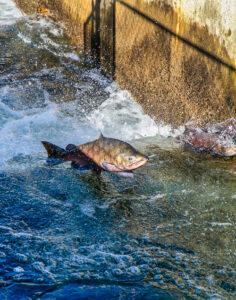
A little more on what causes returning hatchery fish to stray, with a look at the influence of which reservoirs are being released in the fall and which aren’t.
Astute observers have pointed out for years that fall reservoirs releases, when salmon return, often have more influence on where the fish end up than whether and where they were trucked as babies.
Although fish from the Coleman hatchery can be the exception, due to the nearly 300 miles of Delta and river they need to navigate to get home, there’s an interesting story to tell about them.
Coleman fish that returned in 2017 were mostly born in 2014 and trucked to Rio Vista in the Delta in large numbers in 2015. Most didn’t return to Coleman. This has been blamed largely on their being released in the Delta without the benefit of smelling and learning the upper Sacramento River watershed before their truck ride. However, it’s hard to ignore the influence of the extra water released from Oroville in the summer and fall of 2017, where many of these Coleman fish ended up.
A prominent river guide out of Redding recalls that many Coleman fish piled up at the Thermalito Outlet hole on the Feather River in 2017. Instead of guiding and fishing the Barge Hole and other upper river spots, he put his whole season in down on the Feather.
This massive return of kings to the Feather River coincided with the emptying of Lake Oroville to do emergency repairs on the spillway that had been badly damaged that spring.
In order to empty the lake, which was full to the brim by one of the wettest winters in many years, the CA Dept. of Water Resources released over 10,000 cubic feet of water per second of water during the summer and into the fall. In other words, releases from Lake Oroville kept the downstream Feather River roaring that entire summer and into fall.
When fall run salmon returned to the Sacramento River, including Coleman hatchery fish, they detoured up into the Feather in response to the huge volume of water hitting them in the snout.
This illustrates that the plumbing, and which faucets are turned on and off, likely plays a big role in where fish return to. Basically, in 2017, the faucet on the Feather was turned all the way up and the one on the upper Sacramento at Shasta Dam, not as much. So the fish stacked into the Feather.
Near-record return of spring run lost on Butte Creek
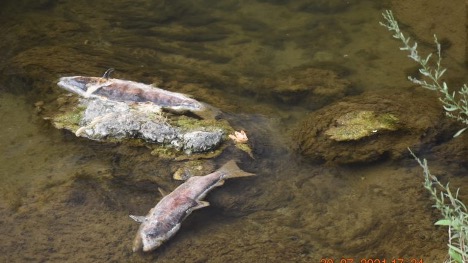
This year saw a near-record return of up to 25,000 spring fun king salmon to Butte Creek. These are some of the last truly wild salmon in the Central Valley. Some have speculated that we got such a strong return for a few reasons including the very wet spring in 2019 when these fish were babies out migrating to the ocean. Another reason could be the heavy sediment runoff from a fire that burned the Butte Creek drainage in the prior summer. At the time, there was fear that runoff would bury the incubating eggs and smother them in sediment. Instead, it looks like the eggs hatched and the additional sediment probably helped hide the fry and smolts in turbid water that washed out of the Central Valley that spring. What could have been a very big group of spawners this year has mostly died before spawning due to hot water in the creek. As of early August, state officials estimated that over 14,000 died before spawning.
On the Feather River, CDFW reports that about 5,000 adult spring run were tagged and returned to the river this year. Roughly 90% of those females were injected with thiamine to offset potential thiamine deficiency issues. The remaining fish that were not injected will be used as a control for research, but the eggs that are spawned from those fish will be treated for thiamine deficiency during fertilization.
Water flows in the river are very low and the water being released through the Oroville Dam is coming out of the “river valve”, which is basically a drain plug in the very bottom of the dam. This is 47° water and measures in the low to mid 60s downstream, which is good for salmon. However, the fish still have to swim through +70° water in the Sacramento to get to the Feather River, which is a concern.
CDFW believes it will have sufficient broodstock to meet its target of 2 million spring-run, but that depends on what of the tagged adult spring run return to the hatchery when it’s time to collect eggs.
Time to move salmon above rim dams?
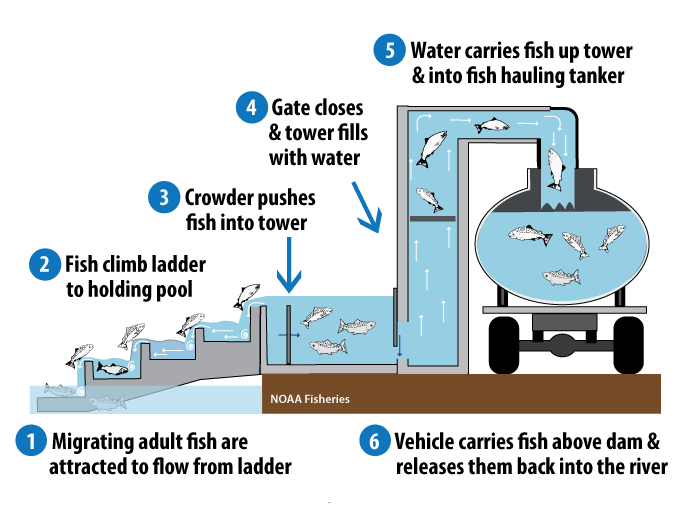
This year’s experience with winter and spring run suggests the future is here now. That means it may be time to consider taking extraordinary measures to keep our salmon. We still have cold streams flowing out of the Sierras into the reservoirs on the major dammed rivers. If salmon could jump or climb over dams, in some places they would still find excellent spawning and rearing streams. In other western states, humans have captured and trucked adult salmon and released them above dams to spawn. The humans have also set up capture facilities on some of these streams to capture the baby salmon that come the next spring. These fish are then put into tanker trucks and released back into the river downstream of the dam. This has met with mixed success and it’s generally expensive to do, but it can work. If the big water districts seize too much water to have sustainable rivers downstream of dams (which is illegal under a state law that is almost never enforced) then maybe it’s time to make them pay to operate trap and haul programs.
Salmon Season Update – August 2021
Some commercial trollers have put in pretty good seasons so far and have caught lots of fish in places most sport fishermen don’t often go. Like far out into the ocean off the Sonoma/Mendocino coastline and at greater depths than are recreationally fished. What they’ve found suggests there were more fish in the ocean at the beginning of the season than officials had forecast. Sportfishing, on the other hand, has been more hit or miss with some good catches near San Francisco and spotty catches out of Bodega. Both sport and commercial have taken a higher than normal number of large salmon, with multiple fish over 40 lbs reported and plenty over 30 lbs.
Because of the relatively good catches north of Bodega Bay well into August, anglers to the south, including out Bodega Bay and the SF area are hopeful they’ll see some good fishing in the weeks ahead.
Meanwhile adult fish have been caught in decent numbers in the upper Sacramento River at the usual spots. Very low flows being released from Lake Oroville on the Feather River may be deterring large numbers of salmon from returning there. We’re hoping enough fish return to the Feather to at least provide the hatchery with the eggs they’ll need for next year’s juveniles. Same with all of the hatcheries.

Here is a unique way to help us keep California’s main salmon runs and the fishing industry strong. Without your help the term “California Salmon” may someday only be used in the past tense.
Every year GSSA hosts four fundraising dinners to raise money via raffles and prize auctions. Quality auction items are the driving force for raising money at these events, which is where you and your company become a vital part of the success of these dinners.
Due to the circumstances of COVID-19, we were forced to cancel an entire year + of GSSA dinners. Since restrictions are getting lighter, we are starting to plan real, live events again and need to build our stash of goods and experiences.
We have found that our fundraisers are not only successful in raising GSSA funds for CA salmon runs, but through social media, emails, and personal relationships many people hear about donated items and the companies and individuals making the donation. This means more exposure for you or your company.
Items such as outdoor gear and accessories, rods, reels, fishing trips, vacation rentals, restaurant experiences, food classes, wine tastings, spa services, golf equipment, art, show tickets, electronics, professional services, and more, can all be auctioned for a good cause.
GSSA is a Nonprofit 501-(C)(3) which means your donation is tax deductible.
Thank you for your consideration of this request, your generosity, and your support of our efforts to rebuild California salmon populations for current and future generations. We appreciate anything you may want to donate and will put it all to good use! If you have goods to donate, email cat@goldenstatesalmon.org
Become a Member and Support Salmon
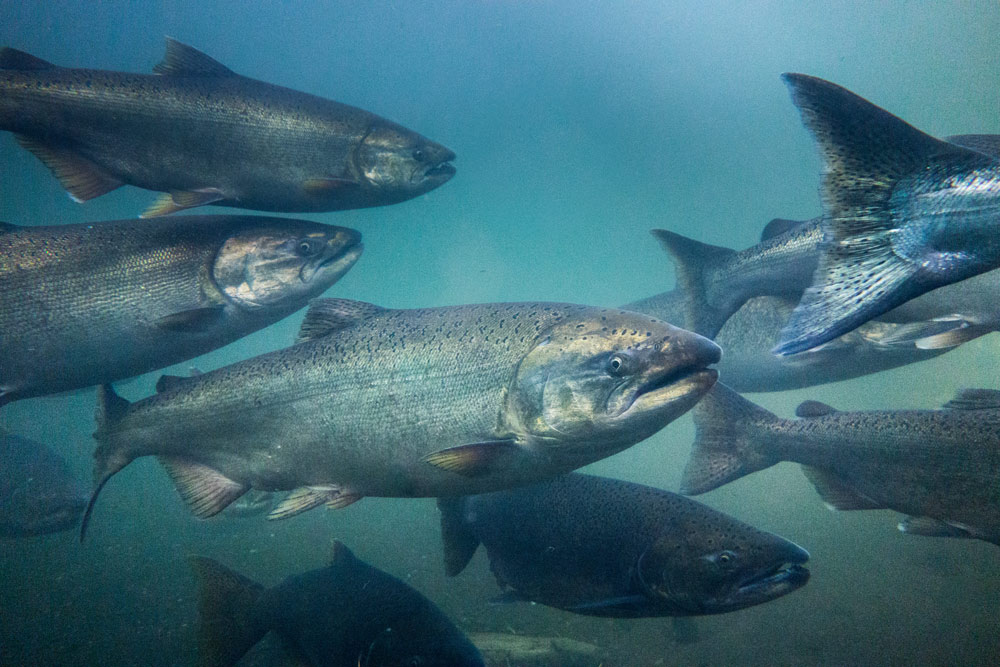
GSSA is to working to improve salmon habitat, hatcheries, and hydrology. We are the only salmon non-profit organization in California working both with elected and government agency policy experts and in the courts to keep salmon in all of our futures. Your membership directly helps our efforts.
